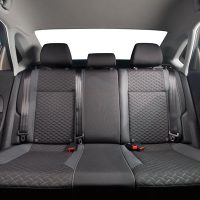Where Is The Safest Seat In The Car?

It is obvious to anyone who has had a driver’s license long enough to renew it that cars are getting safer. Today’s cars jolt you awake if you start acting drowsy and brake on their own if you are getting dangerously close to another vehicle or stationary object. They have a conniption fit if you try to drive when you or any of the other occupants of the car is not wearing a seatbelt. They hook up to your phone so that you can see the navigation system on a screen that is large enough and strategically positioned to prevent you from taking your eyes off the road. By this logic, the safest place to ride in a car is the present, as opposed to the past, when seatbelts were optional, if they were even present at all. Within the same car, with today’s widely available safety features, where is the safest place to ride? Is riding shotgun akin to playing Russian roulette in the event of a collision? Does the back seat lag behind the front seat in safety features? Serious injuries can happen no matter where in the car you are seated, although you are always safer with a seatbelt than without one. A Columbia car accident lawyer can help you if you have been injured in a car accident where you were a passenger.
The Rear Middle Seat Offers the Most Protection From Impact
The rear middle seat is the least preferred seat in the car, the destination of the least assertive of three siblings on a family road trip. It is also the safest place to be in the event of a collision, because, no matter the point of impact, the rear middle passenger does not get a direct hit. Even if it is a rear end collision, there is still a trunk separating the rear seat passengers from the impact. There is a reason that pediatricians advise parents to install infant car seats in the rear middle seat.
Front Seats Have Better Seatbelts
Rear passenger seatbelts have improved a lot over the decades. Until the 1980s, not all cars had them. For a while, front seatbelts were full-fledged safety harnesses that went across the entire torso and hips, while rear seatbelts were only lap belts. Today, rear seatbelts look a lot like front seatbelts, with shoulder and lap components. Modern seatbelts have tensioners, which cause the seatbelt to tighten in the event of a collision, and force limiters, which limit the amount that the belt can tighten, so it does not cause injury. These days, every front seatbelt in a newly manufactured car has both a tensioner and a force limiter. Although the airbag and the seatbelt shoulder strap have made their way to the back seat of every new car, the most advanced seatbelt safety features have not.
Let Us Help You Today
The personal injury lawyers at the Stanley Law Group can help you if you got injured in a car accident where you were a rear passenger. Contact The Stanley Law Group in Columbia, South Carolina or call (803)799-4700 for a free initial consultation.

